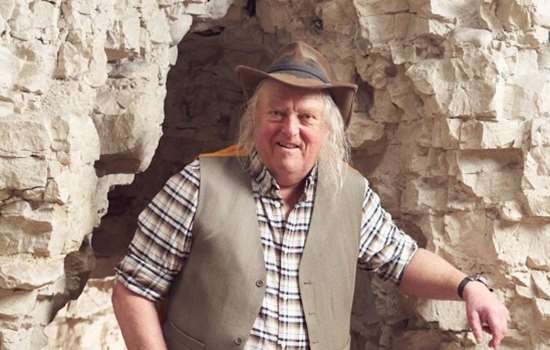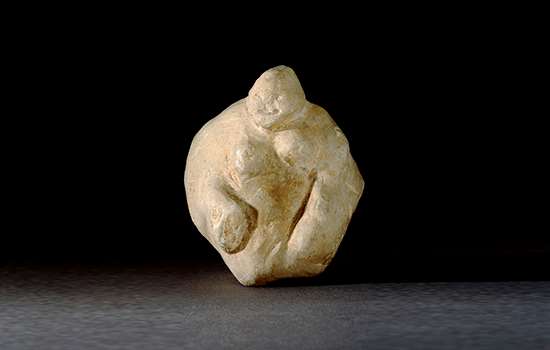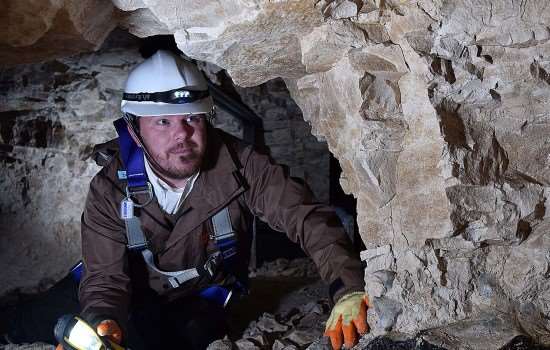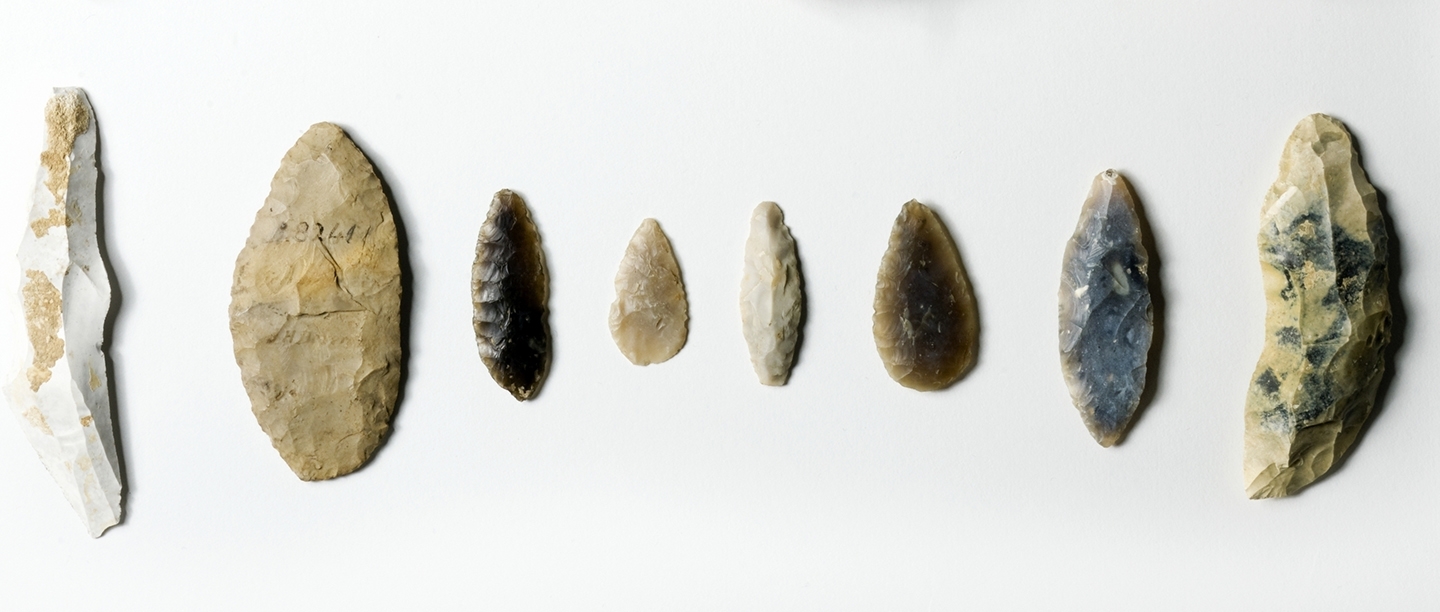Axehead
Axes had important functional uses as tools and weapons. They were also significant status objects and could be polished smooth to make them more visually attractive, requiring hundreds of hours of physical labour.
Many of the locations used in the Neolithic period to source the raw material for making axes are hard to reach, such as rocky outcrops or deep underground. At Langdale in the Lake District, greenstone and hornstone were sourced from high on the mountain scree. At Grime’s Graves the miners had to dig down as deep as 12 metres to reach the ‘floorstone’ layer of flint that they desired.
Unlike earlier flint mines in England, Grime’s Graves was not solely, or even primarily, a site for making axeheads. Research has shown that many different types of tool were made from the flint mined on site.
This axehead was found with a pile of other objects in a service trench near the visitor centre at Grime’s Graves. It was probably discarded by a late Neolithic knapper during production due to a large stone inclusion within the flint.
Sickle
The Neolithic was a period of dynamic change across Britain. Farming was introduced by migrants from the Continent around 4100 BC and gradually began to change the landscape over the course of several thousand years. Ancient woodland was felled and replaced with fields for agriculture and grazing animals.
Tools such as sickles were important additions to this new way of life, allowing Neolithic farmers to cut their crops and prepare the soil. The growth of agriculture meant that people began to live in more fixed communities close to their source of food and work. Several late Neolithic settlements close to Grime’s Graves, such as that at Hockwold cum Wilton, have been excavated and are known to have existed while flint was being mined.
Only half of this sickle remains because it has been broken in two, probably during the knapping process. Like most other examples of flint tools found at Grime’s Graves, it was probably deliberately discarded by the knapper due to faults or them being unhappy with the finished result. Most successfully worked tools were taken away to be traded or exchanged.
Discoidal Knife
The earliest flint mines in England were opened in around 4000 BC on the South Downs. Archaeological evidence suggests that the mines at Grime’s Graves were first dug around 2650 BC, well after many of the earlier mining sites had been abandoned.
It has been suggested that one of the reasons mining was revived on such a large scale at Grime’s Graves was to produce finely worked, specialist tools, with groups of people travelling large distances in order to source them. One tool produced in great quantity at Grime’s Graves was the discoidal knife, a circular cutting implement that was often fully polished or given a polished edge.
Grime’s Graves flint is a rich, glossy black and specialist tools made from it may have been specially prized possessions. Evidence for the unusual importance of this material is shown through the discovery of a huge flint core at West Kennett Farm near Avebury (130 miles away), probably mined at Grime’s Graves. The size of this flint core and its find location within an important monument complex suggests it may have had ritual or symbolic meaning.
Chalk Plaque
To reach the deep layer of high-quality black ‘floorstone’ flint, the miners at Grime’s Graves had to dig through several geological layers of sand, clay and chalk. The mines were open to the sky and mining took place during daylight hours. The white chalk walls of the mine would have reflected the sunlight, making them surprisingly bright spaces to work in.
The softness of chalk makes it perfect for carving or incising marks. Excavations in 1914–15 discovered Neolithic marks inscribed onto the walls of one of the excavated pits (known as Pit 2). They were thought to be a sundial or tally marks measuring the amount of flint that had been mined. In another pit (known as Pit 1) preserved rope marks were found on the walls, demonstrating how flint was lifted to the surface. Numerous chalk carvings and objects have been found in the excavated mines, including the Grime’s Graves goddess.
This chalk plaque, found in 2023, has several lines cut across it, probably made by an antler pick or flint tool. The close-set straight lines suggest that the marks were made deliberately rather than by accident. Whether they had a purpose or conveyed meaning to passing miners is unknown.
Antler Pick
Antler picks were the main tool used to mine and dig for flint. Most of the picks used were shed naturally by red deer, then picked up and prepared by the miners by removing all but one tine. This created a strong bone tool that was perfect for digging through layers of chalk.
When the picks broke through heavy use they were discarded by the miners where they worked. Around 100–150 broken antler picks have been found in each excavated mine, some in the exact position which they were left 4,500 years ago.
To lessen the impact and abrasion of mining on their hands, the Neolithic miners often coated their hands in wet clay when using antler picks. On some well-preserved examples this clay still coats the antler pick, complete with the fingerprints of their last user marked in the clay.
Since 2020 natural earth movement has caused a new window to open in Greenwell’s Pit – the oldest and deepest pit excavated so far at Grime’s Graves. The new window allows a glimpse into an unexcavated mine where two antler picks resting on chalk rubble can be seen, untouched since the mine was backfilled in the late Neolithic.
Sea Urchin and Sea Lily Fossils
During the Cretaceous period, about 145 to 65 million years ago, most of Britain was covered by tropical seas. Skeletons of marine creatures on the sea floor were slowly compressed to form chalk. Flint formed when silica-based lifeforms such as sponges were similarly pressed into the sea floor, eventually fossilising as irregularly shaped lumps or as flat deposits known as tabular flint. The geology of Grime’s Graves is called the ‘Brandon Flint Series’ and is characterised by alternating layers of chalk and flint. The third layer of flint at Grime’s Graves is known as ‘floorstone’ and was prized by Neolithic people for its deep black, glossy appearance.
Among the chalk and flint layers there are fossils of larger marine life, providing a glimpse of the ancient pre-human past. The sea urchin is a member of the genus Micraster, also known as a heart urchin. It has rows of dots which, in life, were pores through the hard outer shell where the tube feet arose. The animal used these to move and burrow with. It lived partially or wholly buried in the sediment at the bottom of the sea. The sea lily is a marine invertebrate (looking much like a plant) which uses a mass of feather-like arms to catch drifting food.
Explore More
-

Grimes Graves Audio Guide
In this audio tour of the site archaeologist Phil Harding and English Heritage historian Dr Jennifer Wexler explore the lunar-like landscape of Grime’s Graves.
-

A Chalk Goddess: Real or Fake?
Many questions have been raised about the authenticity of a figurine discovered at Grime’s Graves in 1939. We explore this intriguing object and learn more about the mysteries that surround its origin.
-

Ritual Mysteries
Intriguing finds from many of the pits at Grime’s Graves suggest that mysterious rituals accompanied the everyday task of mining. Read more about these discoveries here.
-

Virtual Tour
Explore this 360° virtual tour of Greenwell’s Pit, the oldest, deepest and best-preserved pit excavated so far at at Grime’s Graves.

